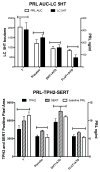Relationships between androgens, serotonin gene expression and innervation in male macaques
- PMID: 24909896
- PMCID: PMC4109686
- DOI: 10.1016/j.neuroscience.2014.05.056
Relationships between androgens, serotonin gene expression and innervation in male macaques
Abstract
Androgen administration to castrated individuals was purported to decrease activity in the serotonin system. However, we found that androgen administration to castrated male macaques increased fenfluramine-induced serotonin release as reflected by increased prolactin secretion. In this study, we sought to define the effects of androgens and aromatase inhibition on serotonin-related gene expression in the dorsal raphe, as well as serotonergic innervation of the LC. Male Japanese macaques (Macaca fuscata) were castrated for 5-7 months and then treated for 3 months with (1) placebo, (2) testosterone (T), (3) dihydrotestosterone (DHT; non-aromatizable androgen) and ATD (steroidal aromatase inhibitor), or (4) Flutamide (FLUT; androgen antagonist) and ATD (n=5/group). This study reports the expression of serotonin-related genes: tryptophan hydroxylase 2 (TPH2), serotonin reuptake transporter (SERT) and the serotonin 1A autoreceptor (5HT1A) using digoxigenin-ISH and image analysis. To examine the production of serotonin and the serotonergic innervation of a target area underlying arousal and vigilance, we measured the serotonin axon density entering the LC with ICC and image analysis. TPH2 and SERT expression were significantly elevated in T- and DHT + ATD-treated groups over placebo- and FLUT + ATD-treated groups in the dorsal raphe (p < 0.007). There was no difference in 5HT1A expression between the groups. There was a significant decrease in the pixel area of serotonin axons and in the number of varicosities in the LC across the treatment groups with T > placebo > DHT + ATD = FLUT + ATD treatments. Comparatively, T- and DHT + ATD-treated groups had elevated TPH2 and SERT gene expression, but the DHT + ATD group had markedly suppressed serotonin axon density relative to the T-treated group. Further comparison with previously published data indicated that TPH2 and SERT expression reflected yawning and basal prolactin secretion. The serotonin axon density in the LC agreed with the area under the fenfluramine-stimulated prolactin curve, providing a morphological basis for the pharmacological results. This suggested that androgen activity increased TPH2 and SERT gene expression but, aromatase activity, and neural production of estradiol (E), may subserve axonal serotonin and determination of the compartment acted upon by fenfluramine. In summary, androgens stimulated serotonin-related gene expression, but aromatase inhibition dissociated gene expression from the serotonin innervation of the LC terminal field and fenfluramine-stimulated prolactin secretion.
Keywords: 5HT1A; SERT; TPH2; androgen; aromatase; serotonin.
Copyright © 2014 IBRO. Published by Elsevier Ltd. All rights reserved.
Figures








References
-
- Abel KM, Cleare AJ. Peripheral hormonal responses to D-fenfluramine as a probe of central serotonergic function in humans. Psychopharmacology. 1999;142:68–72. - PubMed
-
- Aidara D, Robyn C. The effect of testosterone on the secretion of prolactin. Journal de pharmacologie. 1984;15:309–318. - PubMed
-
- Anderson JR. Non-human primates: a comparative developmental perspective on yawning. Front Neurol Neurosci. 2010;28:63–76. - PubMed
-
- Aston-Jones G, Chiang C, Alexinsky T. Discharge of noradrenergic locus coeruleus neurons in behaving rats and monkeys suggests a role in vigilance. Prog Brain Res. 1991b;88:501–520. - PubMed
MeSH terms
Substances
Grants and funding
LinkOut - more resources
Full Text Sources
Other Literature Sources
Research Materials

